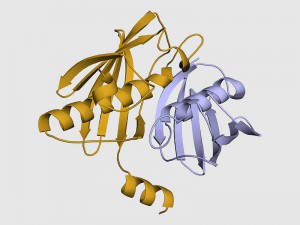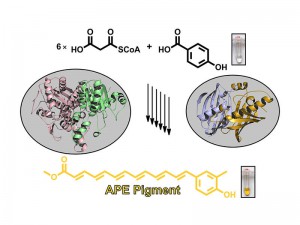Bacteria protect themselves from free radicals using certain natural products in their membrane. Working groups at the Technical University of Munich (TUM) and the Goethe University in Frankfurt have now mapped the biosynthesis of aryl polyenes, the most common protective pigments.

Aryl polyenes are yellow pigments that are produced by many types of bacteria. They are stored in the bacteria membrane and protect the bacteria from oxidative stress, particularly from reactive oxygen species.
As these damage the cells, bacteria try to prevent them from entering through the membrane. Research has already established which proteins are responsible for the formation of aryl polyenes; however, it was unclear how exactly the yellow pigments are build up.
Biosynthesis similar to formation of fatty acids
Together with the working groups of Prof. Helge Bode and Juniorprofessorin Nina Morgner at the Goethe University in Frankfurt, a team of biochemists led by Prof. Michael Groll at TUM were able to recreate the biosynthesis of aryl polyenes in the test tube and establish the function of individual proteins.

“Aryl polyenes have similar anti-oxidative properties to carotinoids, but are produced in a completely different way”, explains Gina Grammbitter from the Goethe University in Frankfurt, who investigated the system as part of her doctorate.
“Their biosynthesis is very similar to the formation of fatty acids, but there are differences”, adds Nina Morgner. “Together with the working group led by Michael Groll, we were able to identify unusual complexes of the proteins involved and determine their structure.”
Yellow pigments part of a larger natural product
The aryl polyenes are produced through a new type of biosynthesis and are located directly in the membrane of the bacteria. However, they are only part of a much more extensive natural product.
Future research should therefore investigate the interaction between the individual enzymes and the role of aryl polyenes in the human microbiome, for example. Aryl polyenes could also be of interest to the cosmetics industry because of their anti-oxidative properties.
Publication:
Gina L. C. Grammbitter, Maximilian Schmalhofer, Kudratullah Karimi, Yi-Ming Shi, Tim A. Schöner, Nicholas J. Tobias, Nina Morgner, Michael Groll, Helge B. Bode: An Uncommon Type II PKS Catalyzes Biosynthesis of Aryl Polyene Pigments J Am Chem Soc. 2019 Mar 25 – DOI: 10.1021/jacs.8b10776
More information:
The research was funded by the European Research Council (ERC), the German Research Foundation (DFG) as part of Collaborative Research Center SFB749 and the Macromolecular Complexes Cluster of Excellence, and by the Federal State of Hesse. The X-ray structural experiments were conducted using the Swiss Light Source PXI beamline at the Paul Scherrer Institute (Villigen, Switzerland).
Source
TUM – Technical University of Munich, press release, 2019-04-08.
Supplier
Goethe-Universität Frankfurt/Main
Technische Universität München (TUM)
Share
Renewable Carbon News – Daily Newsletter
Subscribe to our daily email newsletter – the world's leading newsletter on renewable materials and chemicals













